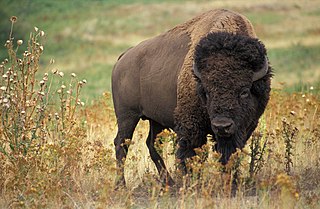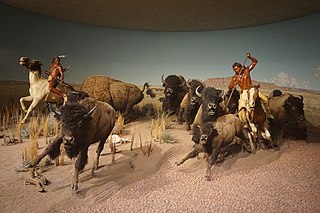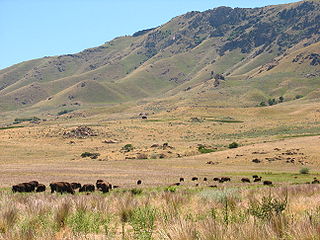Related Research Articles

Bison are large bovines in the genus Bison within the tribe Bovini. Two extant and numerous extinct species are recognised.

The European bison or the European wood bison, also known as the wisent, the zubr, or sometimes colloquially as the European buffalo, is a European species of bison. It is one of two extant species of bison, alongside the American bison. The European bison is the heaviest wild land animal in Europe, and individuals in the past may have been even larger than their modern-day descendants. During late antiquity and the Middle Ages, bison became extinct in much of Europe and Asia, surviving into the 20th century only in northern-central Europe and the northern Caucasus Mountains. During the early years of the 20th century, bison were hunted to extinction in the wild.

The American bison, also called the American buffalo or simply buffalo, is a species of bison native to North America. It is one of two extant species of bison, alongside the European bison. Its historical range, by 9000 BC, is described as the great bison belt, a tract of rich grassland that ran from Alaska to the Gulf of Mexico, east to the Atlantic Seaboard, as far north as New York, south to Georgia and, according to some sources, further south to Florida, with sightings in North Carolina near Buffalo Ford on the Catawba River as late as 1750. Once roaming in vast herds, the species nearly became extinct by a combination of commercial hunting and slaughter in the 19th century and introduction of bovine diseases from domestic cattle. With a population of 60 million in the late 18th century, the species was culled down to just 541 animals by 1889 as part of the subjugation of the Native Americans, for whom the American bison was a food source. Recovery efforts expanded in the mid-20th century, with a resurgence to roughly 31,000 wild bison as of March 2019. For many years, the population was primarily found in a few national parks and reserves. Through multiple reintroductions, the species now freely roams wild in several regions in the United States, Canada, and Mexico, with it also being introduced to Yakutia in Russia.

Elk Island National Park is a national park in Alberta, Canada, that played an important part in the conservation of the Plains bison. The park is administered by the Parks Canada Agency. This "island of conservation" is 35 km (22 mi) east of Edmonton, along the Yellowhead Highway, which goes through the park. It is Canada's eighth smallest in area but largest fully enclosed national park, with an area of 194 km2 (75 sq mi).

Wood Buffalo National Park is the largest national park of Canada at 44,741 km2 (17,275 sq mi). It is located in northeastern Alberta and the southern Northwest Territories. Larger in area than Switzerland, it is the second-largest national park in the world. The park was established in 1922 to protect the world's largest herd of free-roaming wood bison. They became hybridized after the introduction of plains bison. The population is currently estimated at about 3,000. It is one of two known nesting sites of whooping cranes.

A white buffalo or white bison is an American bison possessing white fur, and is considered sacred or spiritually significant in several Native American religions; therefore, such buffalo are often visited for prayer and other religious rituals. The coats of buffalo are almost always brown and their skin a dark brown or black; however, white buffalo can result from one of several physical conditions:

Plains Indians or Indigenous peoples of the Great Plains and Canadian Prairies are the Native American tribes and First Nation band governments who have historically lived on the Interior Plains of North America. While hunting-farming cultures have lived on the Great Plains for centuries prior to European contact, the region is known for the horse cultures that flourished from the 17th century through the late 19th century. Their historic nomadism and armed resistance to domination by the government and military forces of Canada and the United States have made the Plains Indian culture groups an archetype in literature and art for Native Americans everywhere.

A bovid hybrid is the hybrid offspring of members of two different species of the bovid family. There are 143 extant species of bovid, and the widespread domestication of several species has led to an interest in hybridisation for the purpose of encouraging traits useful to humans, and to preserve declining populations. Bovid hybrids may occur naturally through undirected interbreeding, traditional pastoral practices, or may be the result of modern interventions, sometimes bringing together species from different parts of the world.

The wood bison or mountain bison, is a distinct northern subspecies or ecotype of the American bison. Its original range included much of the boreal forest regions of Alaska, Yukon, western Northwest Territories, northeastern British Columbia, northern Alberta, and northwestern Saskatchewan.

The plains bison is one of two subspecies/ecotypes of the American bison, the other being the wood bison. A natural population of Plains bison survives in Yellowstone National Park and multiple smaller reintroduced herds of bison in many places in the United States as well as southern portions of the Canadian Prairies.

The Fort Belknap Indian Reservation is shared by two Native American tribes, the A'aninin and the Nakoda (Assiniboine). The reservation covers 1,014 sq mi (2,630 km2), and is located in north-central Montana. The total area includes the main portion of their homeland and off-reservation trust land. The tribes reported 2,851 enrolled members in 2010. The capital and largest community is Fort Belknap Agency, at the reservation's north end, just south of the city of Harlem, Montana, across the Milk River.
William Michael Gear, better known as W. Michael Gear, is an American writer and archaeologist. He is the author of North America's Forgotten Past series, co-written with wife Kathleen O'Neal Gear.
Kathleen O'Neal Gear is an American archaeologist and writer. She has won numerous awards for her work, including the Spur Award for best historical novel of the west, and two Special Achievement Awards from the U.S. Dept. of the Interior for her work as an archaeologist. In 2015, she was honored by the United States Congress with a Certificate of Special Congressional Recognition. In 2021 she won the Owen Wister Award for lifetime contributions to western literature, and was inducted into the Western Writers Hall of Fame. Her novels have been published in 29 languages.

Albino gaur or white bison are a type of gaur, occasionally seen in the Manjampatti Valley, a 110.9 km2 (42.8 sq mi) protected area at the eastern end of Indira Gandhi Wildlife Sanctuary and National Park in Coimbatore District, Tamil Nadu, South India. They are occasionally called Manjampatti white bison. These gaur are notable for their distinctive ash-grey color as opposed to the almost black color of most gaur. Since 1929, there have been at least 19 documented sightings of these rare animals, including the 2004 photographs of N. A. Naseer.

Bison hunting was an activity fundamental to the economy and society of the Plains Indians peoples who inhabited the vast grasslands on the Interior Plains of North America, prior to the animal's near-extinction in the late 19th century following US expansion into the West. Bison hunting was an important spiritual practice and source of material for these groups, especially after the European introduction of the horse in the 16th through 18th centuries enabled new hunting techniques. The species' dramatic decline was the result of habitat loss due to the expansion of ranching and farming in western North America, industrial-scale hunting practiced by non-Indigenous hunters, increased Indigenous hunting pressure due to non-Indigenous demand for bison hides and meat, and cases of deliberate policy by settler governments to destroy the food source of the Indigenous peoples during times of conflict.

The Antelope Island bison herd is a semi–free-ranging population of American bison in Antelope Island State Park in Great Salt Lake, Utah. Bison were introduced to Antelope Island in 1893. The herd is significant because it is one of the largest and oldest publicly owned bison herds in the nation. The Antelope Island bison herd currently numbers between 550 and 700 individuals. Though the bison on Antelope Island are Prairie bison, which was the most common bison subspecies in North America, the bison have a distinct genetic heritage from many of the other bison herds in the United States and they are considered to be desirable as part of the breeding and foundation stock for other bison herds, because of their separate genetic heritage and some of the distinct genetic markers that are found in the population.

The Yellowstone Park bison herd is a bison herd in Yellowstone National Park. It is probably the oldest and largest public bison herd in the United States, estimated in 2020 to be 4,800 bison. The bison in the Yellowstone Park bison herd are American bison of the Plains bison subspecies. Yellowstone National Park may be the only location in the United States where free-ranging bison were never extirpated, since they continued to exist in the wild and were not reintroduced.
The Henry Mountains bison herd, numbering 250 to 400 bison, is one of only four free-roaming herds on public lands in North America. The other three herds are the Yellowstone Park bison herd which was the ancestral herd for the Henry Mountains animals, the Wind Cave bison herd in South Dakota and the herd on Elk Island in Alberta, Canada.

The Wind Cave bison herd is a herd of 250–400 American bison in Wind Cave National Park, South Dakota, United States. As an active participant in the conservation of American bison, it is believed to be one of only seven free-roaming and genetically pure herds on public lands in North America. The other six herds are in Yellowstone Park, Theodore Roosevelt National Park, Henry Mountains, Blue Mounds State Park (Minnesota), Minneopa State Park (Minnesota), and Elk Island National Park. The Wind Cave herd are of the Plains bison subspecies.
The conservation of bison in North America is an ongoing, diverse effort to bring American bison back from the brink of extinction. Plains bison, a subspecies, are a keystone species in the North American Great Plains. Bison are a species of conservation concern in part because they suffered a severe population bottleneck at the end of the 19th century. The near decimation of the species during the 1800s unraveled fundamental ties between bison, grassland ecosystems, and indigenous peoples’ cultures and livelihoods.# English speakers used the word buffalo for this animal when they arrived. Bison was used as the scientific term to distinguish them from the true buffalo. Buffalo is commonly used as it continues to hold cultural significance, particularly for Indigenous people. Recovery began in the late 1800s with a handful of individuals independently saving the last surviving bison.# Dedicated restoration efforts in the 1900s bolstered bison numbers though they still exist in mostly small and isolated populations. Expansion of the understanding of bison ecology and management is ongoing. The contemporary widespread, collaborative effort includes attention to heritage genetics and minimal cattle introgression.#
References
- ↑ "Passing of North Dakota Icon". www.buffalomuseum.com. Archived from the original on 2016-11-17.
- ↑ "White Cloud, North Dakota's famed albino buffalo, dies of old age". 16 November 2016.
- ↑ "Home". nationalbuffalomuseum.com.